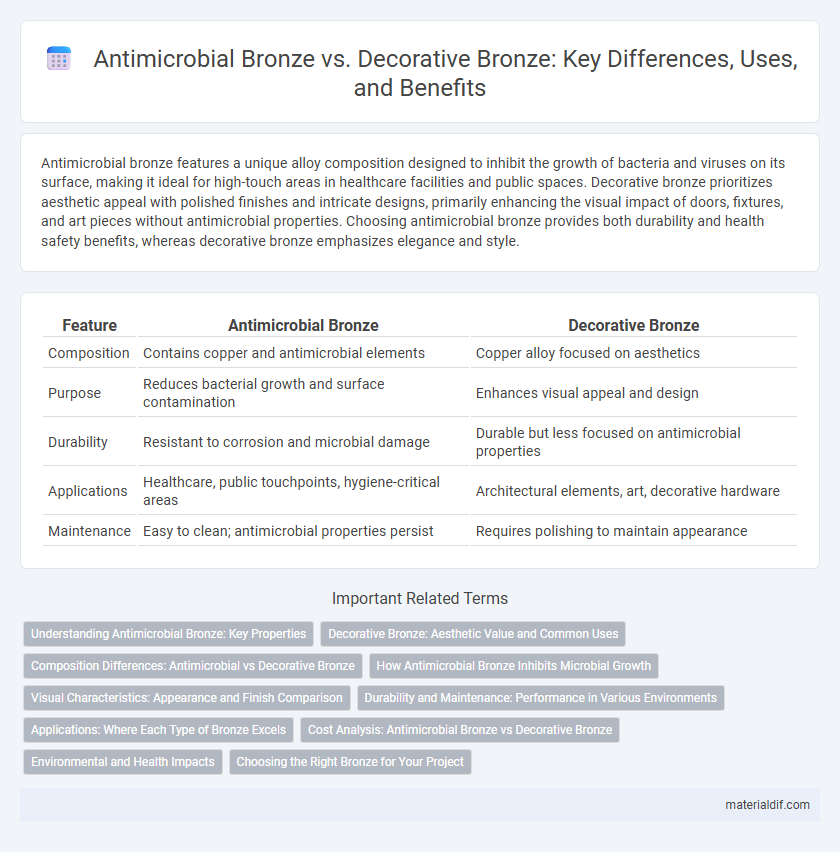Antimicrobial bronze features a unique alloy composition designed to inhibit the growth of bacteria and viruses on its surface, making it ideal for high-touch areas in healthcare facilities and public spaces. Decorative bronze prioritizes aesthetic appeal with polished finishes and intricate designs, primarily enhancing the visual impact of doors, fixtures, and art pieces without antimicrobial properties. Choosing antimicrobial bronze provides both durability and health safety benefits, whereas decorative bronze emphasizes elegance and style.
Table of Comparison
| Feature | Antimicrobial Bronze | Decorative Bronze |
|---|---|---|
| Composition | Contains copper and antimicrobial elements | Copper alloy focused on aesthetics |
| Purpose | Reduces bacterial growth and surface contamination | Enhances visual appeal and design |
| Durability | Resistant to corrosion and microbial damage | Durable but less focused on antimicrobial properties |
| Applications | Healthcare, public touchpoints, hygiene-critical areas | Architectural elements, art, decorative hardware |
| Maintenance | Easy to clean; antimicrobial properties persist | Requires polishing to maintain appearance |
Understanding Antimicrobial Bronze: Key Properties
Antimicrobial bronze contains copper alloys designed to inhibit bacterial growth, leveraging copper's inherent antimicrobial properties to reduce surface contamination effectively. Unlike decorative bronze, which prioritizes aesthetic appeal with polished finishes and diverse patinas, antimicrobial bronze emphasizes functionality by integrating specific copper content levels to ensure consistent antimicrobial efficacy. Understanding the copper alloy composition and its impact on microbial inhibition is essential for applications demanding hygienic surface conditions such as healthcare and public spaces.
Decorative Bronze: Aesthetic Value and Common Uses
Decorative bronze is prized for its rich color variations and elegant patina, making it a popular choice in architectural elements, sculptures, and interior design accents. Unlike antimicrobial bronze, which prioritizes hygienic properties by incorporating copper alloys to inhibit microbial growth, decorative bronze focuses on aesthetic appeal and durability. Its common uses include ornate fixtures, jewelry, and artistic installations, where visual impact and classic beauty are paramount.
Composition Differences: Antimicrobial vs Decorative Bronze
Antimicrobial bronze contains higher copper content, typically above 60%, to leverage copper's natural antimicrobial properties that inhibit bacterial growth on surfaces. Decorative bronze often includes additional elements like tin, zinc, or aluminum to enhance aesthetic appeal and durability but with lower copper percentages, reducing its antimicrobial effectiveness. The compositional shift in antimicrobial bronze is scientifically designed to balance durability with potent biocidal activity, contrasting with the primarily ornamental focus of decorative bronze alloys.
How Antimicrobial Bronze Inhibits Microbial Growth
Antimicrobial bronze contains copper ions that disrupt the cell membranes of bacteria, effectively inhibiting microbial growth on its surface. This alloy releases controlled amounts of copper ions, which generate reactive oxygen species that damage microbial DNA and proteins. Unlike decorative bronze, antimicrobial bronze actively reduces harmful pathogens, making it ideal for high-touch environments requiring enhanced hygiene.
Visual Characteristics: Appearance and Finish Comparison
Antimicrobial bronze features a functional finish with a subtle, matte patina designed to inhibit microbial growth, often exhibiting a slightly duller, more utilitarian appearance compared to decorative bronze. Decorative bronze typically boasts a polished, shiny surface with varied patinas and intricate finishes that emphasize aesthetic appeal and elegance. While antimicrobial bronze prioritizes surface durability and hygiene, decorative bronze focuses on visual richness and decorative effect, resulting in distinctly different tactile and visual experiences.
Durability and Maintenance: Performance in Various Environments
Antimicrobial bronze exhibits superior durability and resistance to microbial growth, making it ideal for high-touch environments such as healthcare facilities and public spaces. Decorative bronze, while visually appealing and corrosion-resistant, requires regular maintenance to prevent tarnishing and maintain its aesthetic quality. The antimicrobial properties in specialized bronze alloys enhance longevity and reduce cleaning frequency compared to standard decorative bronze in harsh or frequently used settings.
Applications: Where Each Type of Bronze Excels
Antimicrobial bronze is ideal for high-contact surfaces in healthcare, food processing, and public transportation due to its ability to continuously reduce harmful bacteria and pathogens, enhancing hygiene and safety. Decorative bronze excels in architectural elements, sculptures, and ornamental hardware, where its aesthetic appeal, corrosion resistance, and ability to take a polished finish make it the preferred choice for visible, design-focused applications. Each type of bronze is selected based on the balance between functional sanitation needs and visual design requirements in various industries.
Cost Analysis: Antimicrobial Bronze vs Decorative Bronze
Antimicrobial bronze typically incurs a higher initial cost compared to decorative bronze due to the incorporation of copper alloys with proven germ-killing properties. Maintenance expenses for antimicrobial bronze can be lower over time, as its natural resistance to bacteria reduces the need for frequent cleaning and chemical treatments. Decorative bronze offers a more affordable upfront investment but may require additional hygiene measures and upkeep, increasing long-term expenses in settings demanding antimicrobial performance.
Environmental and Health Impacts
Antimicrobial bronze contains copper alloys known for their ability to reduce bacterial growth, contributing to improved hygiene and minimizing the spread of pathogens in healthcare and public settings. Decorative bronze, while aesthetically appealing, lacks these biocidal properties, which may result in higher microbial persistence on surfaces. The use of antimicrobial bronze supports environmental health by reducing the need for harsh chemical disinfectants, thereby lowering chemical runoff and associated ecological damage.
Choosing the Right Bronze for Your Project
Antimicrobial bronze contains specific copper alloys that inhibit bacterial growth, making it ideal for healthcare and high-touch environments where hygiene is critical. Decorative bronze, valued for its aesthetic appeal and rich patina, is preferred in architectural elements, sculptures, and furniture where style and durability are key. Selecting the right bronze depends on your project's functional needs and environmental exposure, balancing antimicrobial efficacy with design considerations.
Antimicrobial Bronze vs Decorative Bronze Infographic

 materialdif.com
materialdif.com